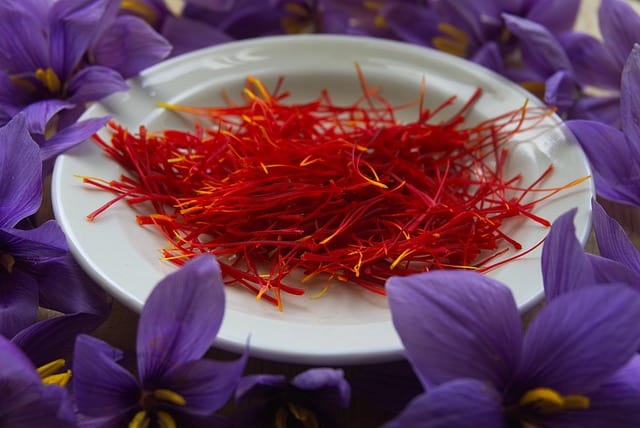Saffron is widely purported to not only be one of the most expensive spices in the world but perhaps the most expensive. So it stands to reason that if you like to use it, you might consider growing it yourself and wonder if you live in a climate that is conducive to doing so.
Saffron is a high-value spice that is primarily grown in areas with a Mediterranean climate, which is characterized by mild, wet winters and hot, dry summers. The ideal climate for growing saffron is one that has cool, dry winters and warm summers with plenty of sunshine.
Specifically, saffron is typically grown in regions with a summer-dry climate, such as in parts of Iran, Spain, Greece, Italy, and Kashmir. These regions have a combination of low winter temperatures and high summer temperatures, which allow the saffron bulbs to go dormant during the winter and then sprout and grow during the warmer months.
What parts of the US are conducive to growing saffron?
Saffron can be grown in certain regions of the United States, but it is important to choose a location that has the right climate and growing conditions. Generally, saffron grows best in areas with a Mediterranean climate, which is characterized by mild, wet winters and hot, dry summers.
In the United States, areas with a similar climate to the Mediterranean are found in California, particularly in the southern and central parts of the state. Other regions with a Mediterranean climate include the Pacific Northwest, where the climate is cooler and wetter than in California, but still suitable for saffron cultivation.
Saffron can also be grown in regions with a high elevation and a dry climate, such as in parts of Colorado, New Mexico, and Arizona. These regions have cool, dry winters and warm, sunny summers, which are ideal for saffron growth.
When growing saffron in the United States, it is important to provide the right soil conditions and drainage. Saffron prefers well-drained, sandy soil with a pH between 6 and 8. Additionally, saffron bulbs should be planted in areas with good air circulation and protected from excessive rainfall and high humidity.
Overall, the best parts of the US for growing saffron are regions with a Mediterranean climate or high elevation areas with a dry climate, such as in parts of California, the Pacific Northwest, Colorado, New Mexico, and Arizona.
Tips to grow saffron at home
Growing saffron at home can be a rewarding experience, as it allows you to produce your own high-quality spice which is both an achievement and a money saver. If you live in a zone that is conducive to growing saffron and want to give it a try, here are some suggestions to do it successfully:
- Choose the right location: Choose a location with well-draining soil, good air circulation, and protection from excessive rainfall and high humidity.
- Planting: Plant saffron bulbs in the fall, about 4″ to 6″ apart and 2″ to 3″ deep in the soil. Saffron bulbs prefer well-drained, sandy soil with a pH between 6 and 8.
- Watering: Saffron bulbs should be kept moist, but not waterlogged. Water them regularly during the growing season, but reduce watering during the dormant period.
- Fertilization: Saffron does not require a lot of fertilizer, but you can apply a balanced fertilizer once or twice during the growing season. Look for a balanced formula with a nitrogen-phosphorus-potassium (N-P-K) ratio of around 10-10-10 or 8-8-8. Avoid using fertilizers that are high in nitrogen, as this can promote vegetative growth at the expense of flower production.
- Harvesting: Saffron flowers appear in the fall and should be harvested as soon as they open. Carefully remove the stigmas from the flowers using tweezers or your fingers, and allow them to dry completely.
- Storing: Store saffron in an airtight container in a cool, dry place. Saffron can be stored for up to two years. Click here for some tips on saffron storage.
- Pest and disease control: Saffron is susceptible to pests and diseases, such as spider mites, aphids, and fungal diseases. Use organic pest control methods, such as neem oil, and avoid overhead watering to prevent fungal diseases.
Overall, growing saffron at home requires some attention to detail, but it can be a rewarding and enjoyable experience. With the right location, soil conditions, and care, you can produce your own high-quality saffron spice.
What countries produce the most saffron?
Iran is the largest producer of saffron in the world, accounting for around 90% of the global production. Saffron is a key agricultural product in Iran and is grown in several provinces across the country, with the province of Khorasan being the largest producer.
Other major saffron producing countries include Spain, which is the second-largest producer, as well as Greece, Italy, Morocco, and India. These countries account for the remaining 10% of the global saffron production.
In recent years, there has been a growing interest in saffron cultivation in other parts of the world, such as in Afghanistan, Australia, New Zealand, and the United States, among others. However, the production in these countries is still relatively small compared to the major producers mentioned above.
Summary
In general, saffron requires a warm, sunny climate with well-draining soil and moderate to low rainfall. High humidity and excessive rainfall can damage the delicate saffron flowers and make them susceptible to fungal diseases, so it’s important to choose a location with a dry climate or provide proper drainage to prevent waterlogging.
In summary, the best climate zones for growing saffron are regions with a Mediterranean climate or a summer-dry climate, with cool, dry winters and warm, sunny summers.

